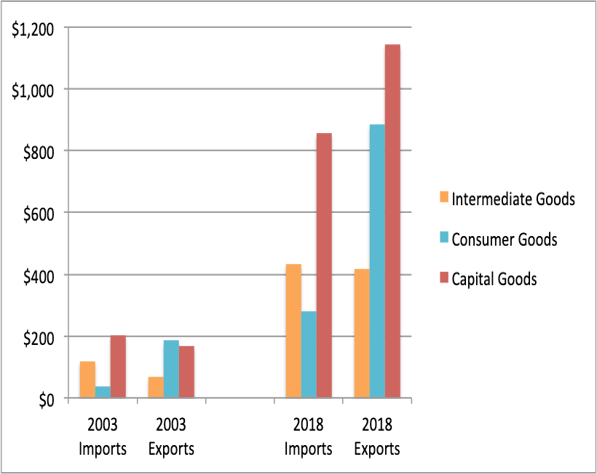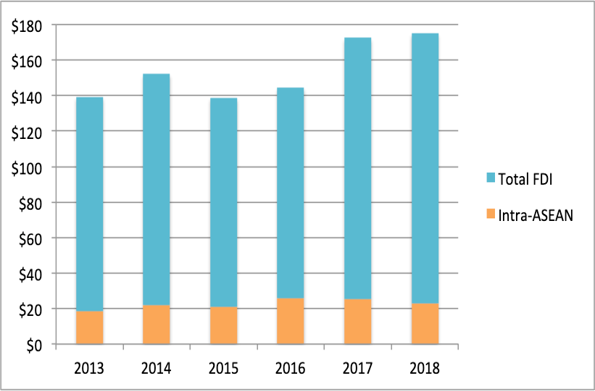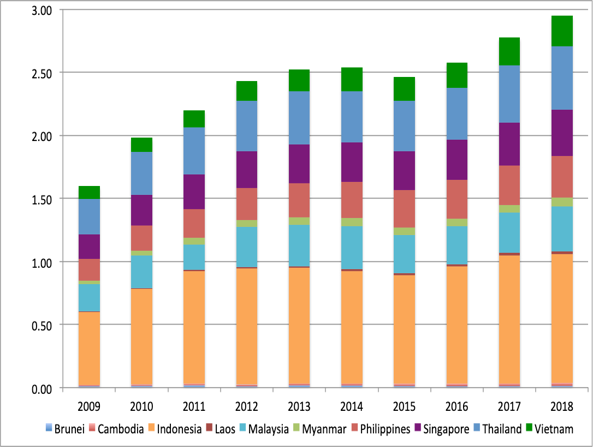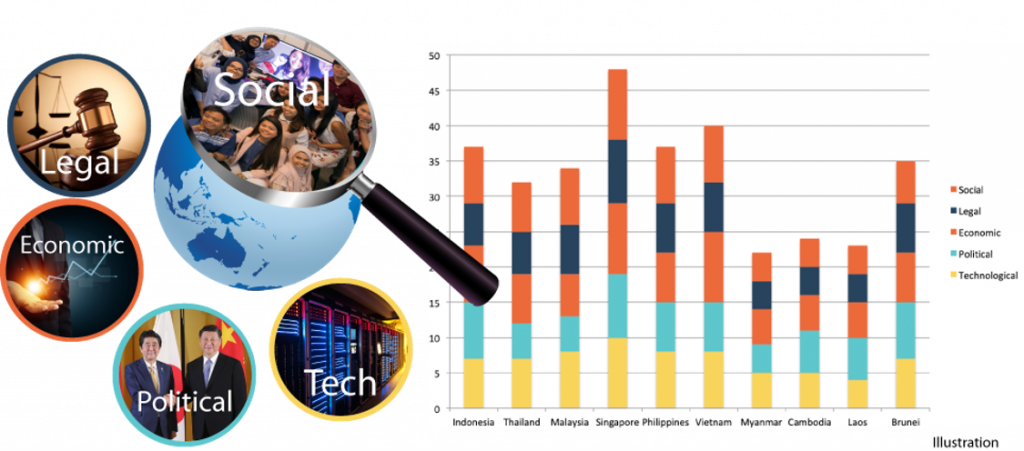
As a long term resident of Singapore I’ve been a champion of western companies, mainly Canadian, making the strategic choice to capitalize on trade and investment opportunities in the ASEAN region.
The combination of U.S.-China trade frictions, and the recent outbreak of the Coronavirus and subsequent disruption to the Chinese economy and global supply chain give cause to more deeply evaluate Asia market entry and development strategies.
At the time of the first severe infectious disease to emerge in the 21st century, the SARS outbreak in 2003, the Chinese economy looked like this:
- Economy $1,670b
- Trade $851b
- Exports $438b
- Imports $413b
- Balance + $70b
- Inward FDI $53b
Nearly two decades later the numbers had grown to:
- Economy $13,608b
- Trade $5,084b
- Exports $2,494b
- Imports $2,135b
- Balance + $179b
- Inward FDI was $203b
Over the past 17 years, China has soared as Asia’s primary investment, trade and development target. It has rapidly evolved from the low cost, low value global factory floor to a value-added manufacturing nation and primary supply partner of intermediary, consumer and capital goods to many companies across a wide range of global vertical markets.
The COVID-19 outbreak of 2020 should be a red flag of vulnerability to companies that may have an over-concentration and over-dependence on China as a market to sell goods and services and as a single source supply partner.

Regional and global disruption
The COVID-19 virus will adversely affect small to midsize businesses to fortune 200 multinationals alike without prejudice and discretion. SMEs make up more than 90% of the registered companies in China, and most expect to face a cash crisis in three months should the virus continue to choke the Chinese economy.
Apple recently reported it would fail to meet first quarter earning guidance due to “supply constraints” and the dramatic drop in Chinese shoppers during the virus crises. Analysts have estimated Chinese demand for smartphones may drop by half during the first quarter of 2020.
The domestic and global car and equipment industry is another sector that has been affected by disruption to its supply chain. Last week, the heavy equipment manufacturer JCB said it was cutting production in the UK because of a shortage of components from China.
Luxury brands which have previously shown great immunity against financial and economic shocks are also affected. Forty-five percent of Burberry revenue comes from Chinese consumers and 40% of its retail outlets are closed due to the virus.
Retail big box and modern trade companies are particularly vulnerable to a prolonged supply disruption. Walmart, for example, sources 70% of its merchandise from China. Global stock exchanges are tumbling, countries are adjusting their economic forecasts, and publicly traded companies are revising their first quarter earnings guidance.
The domestic, regional and global impact of the COVID-19 remains uncertain. However, the head of the International Monetary Fund, Kristalina Georgieva, has said
“there could be a cut of about 0.1-0.2 percentage points to global growth”, but stressed there was “much uncertainty about the virus’s economic impact”.
The call to diversify risk, ASEAN trade, development and investment opportunity
Considering U.S.-China trade tensions, the directional uncertainty of tariffs, and the compounding effect of the COVID-19 virus – is it time to pivot to the ASEAN region to diversify manufacturing and develop as an export market.
Although South East Asia accounts for only 10% of global trade, the ASEAN region is emerging as the global growth engine of the next decade and gateway into new intraregional and interregional markets. Trade agreements will more deeply interconnect the ASEAN region with global markets such as:
- ASEAN Member States (AFTA)
- ASEAN Economic Community (AEC)
- ASEAN-Australia-New Zealand FTA (AANZFTA)
- ASEAN-China FTA (ACFTA)
- ASEAN-India FTA (AIFTA)
- ASEAN-Korea FTA (AKFTA)
- ASEAN-Japan Comprehensive Economic Partnership (AJCEP)
- Vietnam-EU (EVFTA)
- Upcoming Comprehensive and Progressive Agreement for Trans-Pacific Partnership (CPTTP)
- Proposed Regional Comprehensive Economic Partnership (RCEP)
As geopolitical shifting continues to transform global markets, the ASEAN region is emerging as the main recipient for Asia inward Foreign Direct Investment (FDI), attracting a record ~$151b in 2018 and exceeding China’s ~$139b.

The COVID-19 has accelerated the shifting of manufacturing, and Vietnam and Thailand are the most likely beneficiary countries. Samsung shifted production from China to Vietnam in 2019 and now employs 200k Vietnamese workers and production is at full capacity. Samsung moved their production to Vietnam well before the COVID-19 outbreak for two key reasons, the U.S.-China trade war and declining Chinese market share.
Western companies entering the Asia region need to be cognizant to the fact that social and consumer behaviors are shifting in China.
China’s mass urbanized middle-class consumers and 400 million millennials have become less attracted to western brands in favor of local or Asian brands.
China is ASEAN’s main trading partner and the economic impact of the health crisis is cascading into the region. Malaysia, Singapore and Thailand have downgraded their 2020 economic forecasts. However, growth is still projected in several ASEAN countries due to robust intraregional demand and the continuing U.S.-China trade tensions.
New entrants need to look beyond the immediate crises and envision the region as a market opportunity to sell their products and services, investment opportunity to establish local manufacturing and a future export platform.
By the end of the decade ASEAN’s population is projected to grow from 647 to 710 million with a median age of 33. Household earnings for 125 million people in the region will reach 7,000 US$, and about 30% or 40 million will earn between 18,000 to 68,000 US$.
Over the next decade this growing middle class will spur the need for a wide range of consumer goods and services, creating the next Asia growth wave and new opportunities for multinationals.
The more open and democratic economies will compete to attract new FDI and increase the level of foreign ownership in lucrative sectors such as construction, manufacturing, real estate, finance, and retail. The trade bloc’s geographic location in the confluence of major trade routes will enable companies to utilize their ASEAN-based manufacturing as an export platform to supply new interregional and global consumers as globalization and interconnectivity progress.

This region is the new growth opportunity for many western companies wanting to expand and sell their products and services internationally. However, new entrants must take the time to complete their due diligence to make strategic choices on where and how to compete, and more importantly, how to win based on a pragmatic thought process.
The timeline of a development strategy should factor a mid to longer term three stage hierarchical approach:
- First stage: establishing an export business and distribution partners
- Second stage: investing in regional commercial resources and distribution services to scale-up the business
- Third stage: regional manufacturing investment to sustain competitiveness and scale, maximize profitability, and better serve new ASEAN customers
Pre-development and investment macro analysis has become critically important given the backdrop of the COVID-19 outbreak and disruption to regional and global economies.
Within the context of strategic marketing, companies need to look well beyond basic statistical GDP data and generalized knowledge gained from limited exposure to the region.
The Inclusive Development Index (IDI) has become a far more useful and relevant tool to measure a country’s economic progress in addition to GDP. Other sources of reliable and accurate market intelligence should be analyzed and combined to produce a market specific social, legal, economic, political, and technological analysis (SLEPT Analysis).

Social factors
In general social factors evidence an emerging ASEAN middle class, high population growth rate, favorably changing demographics, increased access to education and a more health and environmentally conscience society.
Legal factors
Country specific legal factors are establishing better regulatory mechanisms, improving intellectual property protection, and gender inclusiveness.
Economic factors
Evident in terms of growth, moreover the ASEAN region is financially integrated globally, credit is accessible, and monetary policies are growth focused.
Political factors
Economic policies influence business decisions, and most economies in the ASEAN region are highly favorable to open regionalism, globalization and FDI that creates employment and contributes to society betterment and economic development. In the context of this article governments need to have transparency and responsiveness contingencies to health crises’ such as the COVID-19, climatic disruptions such as the Australian forest fires of 2019 (arguable dependent on personal perspective), and natural disasters such as the Fukushima earthquake in 2013, and tsunami that hit the coasts of several countries of South and Southeast Asia in December 2004.
Technological factors
The ASEAN region’s rapid infrastructure development, fast-paced adaptation to AI and automation, communications and Fintech example technology and innovation that is rapidly outpacing most western economies.
I’ve applied a simplified example of SLEPT analysis fundamentals, but need to emphasize that this is a crucial analytical process that must be qualitative and rated, completed in sufficient detail, be country specific and relevant to your business.
Moreover the SLEPT analysis is only one part of the strategic marketing process, it must be integrated with country specific micro-environmental analysis, business alignment analysis, risk analysis, and other tools to establish the factual basis from which to decide go / no go / how to go / and if you go, how to succeed.
Your level of regional knowledge and commercial expertise will make a difference. My advice if you have limited knowledge of the ASEAN region, is to find an expert who can help you expedite your entry and development.
The world will survive the COVID-19 epidemic as it did SARS in 2003 and H1N1 in 2009. Chinese factories will return to capacity, supply chains will be restored and markets and economies will recover. China will continue to be an important growth market especially for new technology and a key supply source to many companies across global verticals. As we near the end of the 2020 calendar quarter – companies will assess the quarter and estimate full year impact to their businesses. The perfect storm created by the U.S.-China trade war and compounding COVID-19 virus will effect current and future trade, development and FDI decisions. Your Asia development strategy should include the ASEAN region to capitalize on immediate and emerging growth opportunities and to diversify risk.
Data sources
The Future is Asian, Parag Khanna / Carnegie Endowment for International Peace / WITS / Trading Economics / OECD / Enterprise Singapore / Focus Economics






disqus comments